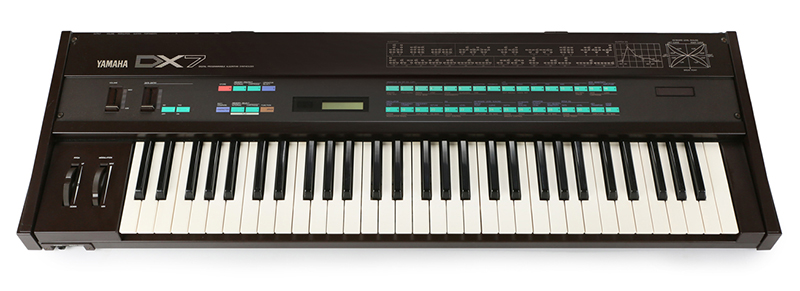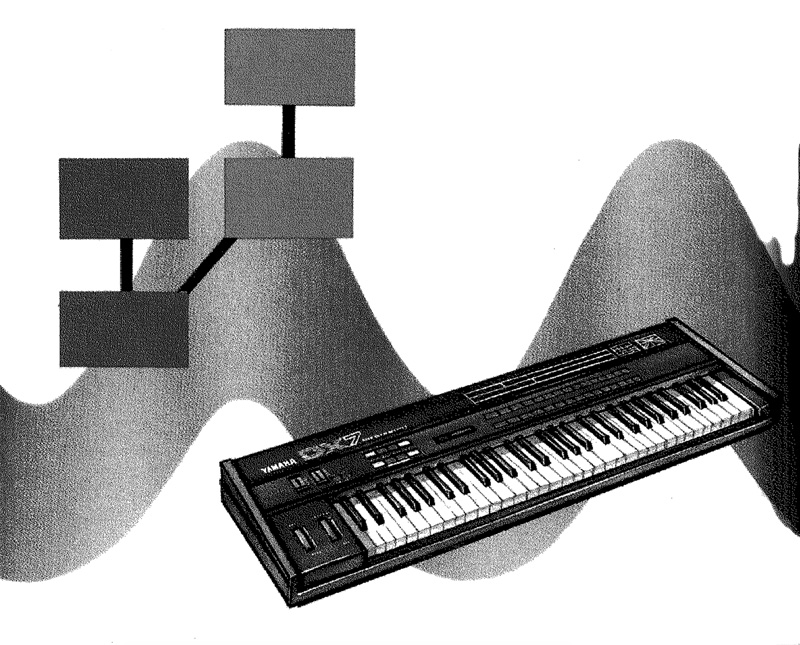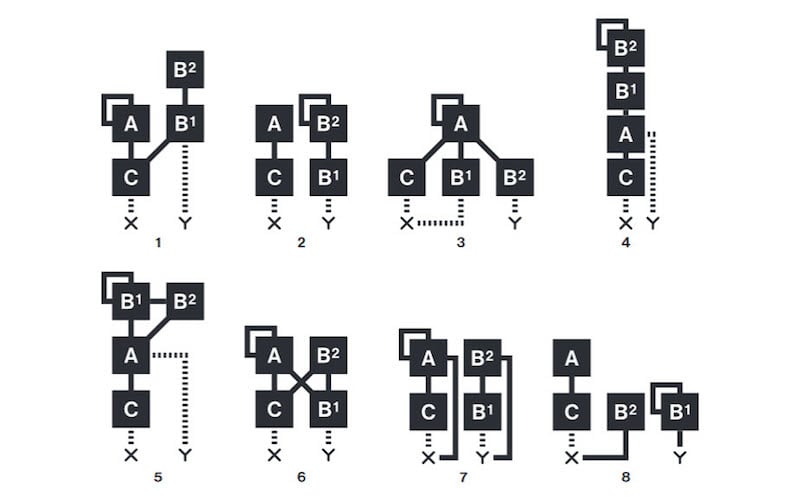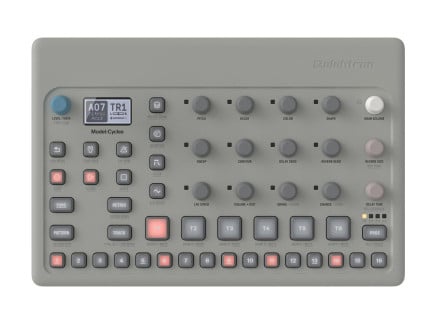FM is a notoriously complex synthesis method. While it is capable of a wide range of tones, it can be frustrating to use because of its combination of esoteric terminology and an enormous number of parameters for every sound. It's not quite as simple as running a saw wave through a resonant lowpass filter—once you start working with FM, you are thrust into a world with operators, indices, ratios, complex envelopes, and algorithms. So when first working with FM, it might feel like you're re-learning synthesis altogether; but once you have a handle on some core concepts, FM can become every bit as rewarding as subtractive synthesis, and can add an entire range of new sounds to your sonic toolkit.
In one of our recent tutorial live streams, our very own Trevor discussed the ins and outs of FM synthesis using the Elektron Digitone. Check out the video above for Trevor's FM walkthrough, and keep reading for a breakdown of some key FM concepts.
Why the Bad Rap?

FM in commercial synth design was pioneered by Yamaha in the 1980s. Having licensed John Chowning's frequency modulation (FM) algorithm, Yamaha was able to create digital synthesizers that combined internal preset memory with then-uncommon synthesis tactics, making it possible for a single polyphonic synth to produce a then-unheard-of array of timbres, all at the push of a button. And what's more, many of Yamaha's FM synths were remarkably affordable—so instruments like the DX-7 quickly grew in popularity, overtaking a huge amount of the overall synth market share.
Because of its price, polyphony, and patch memory (complete with tons of usable presets), the DX-7 and its siblings became remarkably popular. However, their dependency on an esoteric synthesis method unfamiliar to most musicians combined with their minimal user interface meant that many users never really learned to program their own sounds: they instead heavily relied on the internal presets. And even when curious programmers began to dive into the synth's inner workings, they were met with a workflow very much unlike the subtractive synths of the past—rather than dealing with a handful of hands-on parameters (like in a Minimoog or Prophet-5), FM synths can require the coordination of dozens of parameters per sound to produce meaningful results. This means that, if you're unfamiliar with FM, a huge number of parameters per sound might at first seem to have no effect at all if not properly coordinated...leading to an often frustrating, unrewarding learning experience. This combined with the 1-slider user interface of classic FM synths meant that most users never truly mastered FM.
However, by learning some basic terminology and concepts in FM synthesis, programming can be easy—and happily, many modern FM synths have considerably more interactive user interfaces than those of the 1980s DX synths. Let's take a look at some basic FM terms and concepts, as well as what they mean sonically.
FM: Basic Terminology
In FM synthesis, multiple oscillators are used to modulate one another's pitch. By performing this modulation at audio rates, it introduces new harmonics, turning raw sine waves into deep, rich timbres. This is similar to FM in analog oscillators, but typically maintains a cleaner sense of original pitch than in analog contexts. In most FM synths, these oscillators produce only sine waves—and by increasing the modulation depth from one oscillator to the next, you can start to introduce more harmonics.

But we don't normally hear the word "oscillator" thrown around when discussing digital FM. Instead, we use the term "operator." This term carries some other implications—the "operator" concept implies that the oscillator in question may also have an output used to modulate another operator, and that this modulation amount itself is variable. The operator that we wind up hearing is called the carrier, and the operator that modulates the carrier is called the modulator. The amount of modulation coming from a modulator is referred to as a modulation index, or just index.
Of course, the modulation index isn't the only parameter available for changing the relationship between two operators. Another key concept in FM involves the relative tuning of operators...often indicated with frequency ratios, sometimes referred to simply as the FM ratio. By altering the tuning ratio of the modulator to the carrier, you can affect which overtones emerge when the index is increased—and can even affect the overall perceived stability of the resulting sound. By using whole-number ratios (2:1, 3:1, 4:1, etc.), the resulting timbres will be fairly sonorous; by using non-whole number ratios, though, the resulting timbres will be more dissonant and complex.
Two of the key tricks for introducing movement in FM sounds involve modulation of the ratio and index. By using envelopes or LFOs to modulate the ratio, you can change the harmonic structure of a sound over time; by modulating the index, you can alter the brightness or intensity of the FM effect overall. Mastering the use of envelopes in FM is critical: in some situations, an envelope applied to the modulation index alone can be the difference between a bell-like struck tone or a brass-like swell.
By learning what an operator is, what modulator and carrier mean, and what the modulation index and FM ratio are, you're a good way long in understanding FM synthesis altogether.
But What are Algorithms?
One of the scarier concepts when first getting to know FM synthesis is the "Algorithm." And while this sounds like an intimidating term, it's actually a pretty simple idea.
Most FM synths have more than two operators per voice. Many have four or six operators—which you can think of somewhat like having four or six oscillators per voice. However, unlike in synths like a Minimoog, you can't necessarily hear all the operators all the time...often, several of the operators are used purely as modulators, while one or two (or in some cases more) are used as carriers. The configuration of modulators and carriers relative to one another is called an algorithm. Algorithms on FM synths are usually indicated with flowchart-like diagrams, which visually describe how the various operators influence one another, as well as indicating which operators are actually audible.
In theory, an algorithm with six operators could have a huge number of potential arrangements—however, in most FM synths, algorithms are made up of relatively small functional blocks. Certain arrangements of two, three, or four operators are commonly recombined to come up with more complex algorithms; and while these might at first look complicated, they're pretty easy to understand once you've learned how to visually identify the more elemental algorithms.

For instance, check out the eight algorithms above—these are the algorithms in the Elektron Digitone, which is a four-operator FM synth. The operators themselves are labelled A, B1, B2, and C. Each algorithm has two outputs, labelled X and Y: you can crossfade continuously between these, thereby changing which carrier(s) you hear at any given time.
Take a look at algorithm two. Despite having four operators, this is a pretty simple FM setup: it's just two two-operator stacks. A modulates C, and C heads for the X side of the crossfader; B2 modulates B1, and heads to the Y side of the crossfader. This gives you the ability to set up two distinct, independent two-operator tones and fade between them...pretty rad. Algorithm 1, on the other hand, has a pretty different algorithm: it features a two-operator stack like in Algorithm 2 (between operators A and C), but also features a three-operator stack (B2>B1>C). This can result in very different types of timbres, sort of like a blend of two fully independent stacks...but giving you the ability to crossfade between the full stack and a shorter, two-operator stack (B2>B1). If you look, you'll see other patterns emerge: different groupings of two or three operators configured in more or less similar ways. Once you've learned the basic sound of a two oscillator or three oscillator FM stack, wrapping your head around more complex algorithms is actually pretty straightforward. In fact, some say that all algorithms can be broken down into four basic types:
- Stacked algorithms, in which a chain of operators modulate one another in series
- Branch algorithms, in which multiple operators modulate a single operator directly
- Root algorithms, in which one operator modulates multiple carriers directly
- And Carrier-only algorithms, in which multiple carriers are simply heard directly in parallel
And in fact, these are some pretty excellent elemental ways to look at FM algorithms...once you boil things down this plainly, it's fairly easy to start to understand the behavior of what might at first appear to be quite complex algorithms.
You'll also notice on each of these algorithms that one operator has a square-ish line connecting only to itself. This is an indication of the inclusion of FM feedback on that operator—which is to say, you can use that operator to modulate its own frequency. Typically, this results in chaotic, noisy, and metallic timbres, which sometimes can be heard directly (like in Algorithms 7 or 8), but sometimes can only be heard indirectly through their influence on downstream operators (like in all of the other algorithms). This can be a great way to add some edge to your sounds—and often, modulating the feedback index can be enough to go from a static sound to something really biting and intense.
The best way to get the hang of how different algorithms sound is simply to use them. If you try to visually identify patterns in how the algorithms work, you'll start to notice similarities in quality between them, and soon it will be easy to choose which algorithm to go to for any type of sound, from basses to bells and digital chaos.
Of course, there's more to FM than all this—and different instruments take different approaches. While old-school FM synths often used exclusively sine operators, many modern synths (such as the Digitone) allow for use of more complex shapes as operators, instantly opening things up to considerably more complex tones. The X/Y crossfader in the Digitone also is a clever touch...making it easy to get dramatic sonic variation from a single algorithm of only four operators without needing to change the algorithm itself. Additionally, many classic FM synths didn't feature filter stages at all, given the sheer ability of the operators to create complex, interesting tones...but many current FM synths add filters to provide yet another option for altering the flavor of the produced sounds.
We've recently seen other approaches as well: instruments like the Kodamo Essence FM, for instance, allow the creation of completely custom block-based algorithms, allowing another style of precise and highly personal FM control.
No matter if you're using a Korg Volca FM, a DX-7, or a Digitone, FM doesn't need to be scary. Now that you know your way around the basic terms and concepts, dive in and you'll find a whole world of new sounds to explore.










